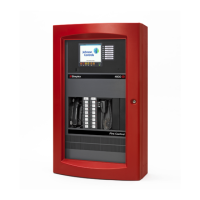73
DELAY BEFORE RESET
The programmer has the ability to set a Reset Time Delay. The delay time period starts after a zone alarm is detected
and runs until the detector is reset. The length of the delay may be from 15 to 60 seconds, and may be adjusted
depending on the method used to simulate an alarm. A longer value is desired if smoke is used to bring in each
detector. By default, the delay is set to 15 seconds.
LOGGING OPTION (LOG/NO LOG)
By default, the system enables the logging of Walk Test
events. When logging is enabled, each zone that comes
into alarm or trouble is time-tagged and added to the Historical Trouble Log. This is very beneficial in cases where
a 100% silent test is required. When testing, remember to record the identity and order of the devices tested. When
the Walk Test
is finished, compare this record with the Historical Trouble Log and verify that all zones activated
correctly. The <F2> key is used to enable/disable the logging of Walk Test
events to the Historical Trouble Log. By
default, logging is enabled.
If the system is configured for a printer and the PRINT REPORT option is selected, the Historical Trouble Log is
printed on the system printer.
MONITOR ZONE LIST
A Monitor Zone List is a point list that contains those monitor zones within a defined area of a building. This list is
initially filled by the system for the first group, and includes all monitor zones. It can be edited using the tag list feature
of the 4100 Programming Unit. An empty list signifies that a Walk Test
group is not used. The programmer has the
option of changing the label of this point list so that it is more meaningful for panel operation. You cannot have the
same zone in more than one Walk Test
group.
PROGRAMMER CONFIGURATION
Walk Test
is a configured feature that may be set up during factory programming, although it is best programmed
in the field with the 4100 Programming Unit. By default, Walk Test
is protected at Access Level 3. The access level
required to enable your Walk Test
is shown on the Programmer’s Report. Walk Test
groups are selected from the
LCD Main Menu. Selecting Walk Test
on the Main Menu brings up the Walk Test
configuration screen which lists
the setup for the Walk Test
groups.
SIG/NO SIG (SILENT Walk Test™ SELECTION)
The <F4> key is used to enable the selection of the Silent Walk Test
. By default, the Silent Walk Test
is enabled.
SYSTEM TROUBLE
The Walk Test
has the ability to test signal circuits for trouble (i.e., open/short) conditions. This is accomplished by
using the Walk Test
output lists (L50 through L57) as the input lists for signal trouble conditions.
For example, if a signal circuit trouble occurs on a point in Walk Test
output list L50 (Group 0), and Walk Test
Group 0 is enabled, the Walk Test
trouble code will play on all signal/speaker circuits in Walk Test
list L50. Note
that the signal trouble is not inhibited. An actual trouble condition will occur at the operator interface panel, but will
be logged as a Walk Test
trouble for that signal. This trouble automatically clears when the signal circuit is returned
to normal in a Global Acknowledge system. In an Individual Acknowledge system, Point P4 (FORCE GLOBAL
ACKNOWLEDGE) must be turned ON before performing a signal circuit Walk Test
. If Walk Test
is not enabled for
the group containing the signal circuit in trouble, the trouble condition passes through without playing the Walk Test
code.

